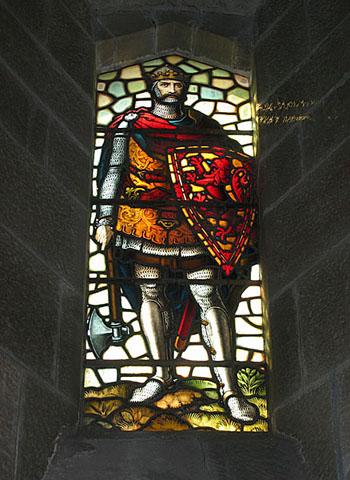
1274 - 1329
In 1314 Pope John XXII recognized Robert the Bruce as King of Scotland, and Scottish independence was secured.
Rex: 1306 - 1329

First War of Scottish Independence
Beginning of the war: 1296-1306
The First War of Scottish Independence can be loosely divided into four phases: the initial English invasion and success in 1296; the campaigns led by William Wallace, Andrew de Moray and various Scottish Guardians from 1297 until John Comyn negotiated for the general Scottish submission in February 1304; the renewed campaigns led by Robert the Bruce between his coronation in 1306 and the Scottish victory at Bannockburn in 1314; and a final phase of Scottish diplomatic initiatives and military campaigns in Scotland, Ireland and Northern England from 1314 until the Treaty of Edinburgh-Northampton in 1328.
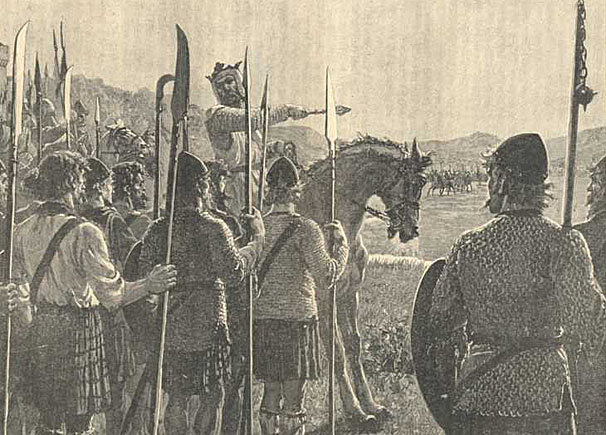
The war began in earnest with Edward I's sacking of Berwick in March 1296, followed by the Scottish defeat at the Battle of Dunbar and the abdication of John Balliol in July. The English invasion campaign had subdued most of the country by August and, after removing the Stone of Destiny from Scone Abbey and transporting it to Westminster Abbey, Edward convened a parliament at Berwick, where the Scottish nobles paid homage to him as King of England. Scotland had been all but conquered.
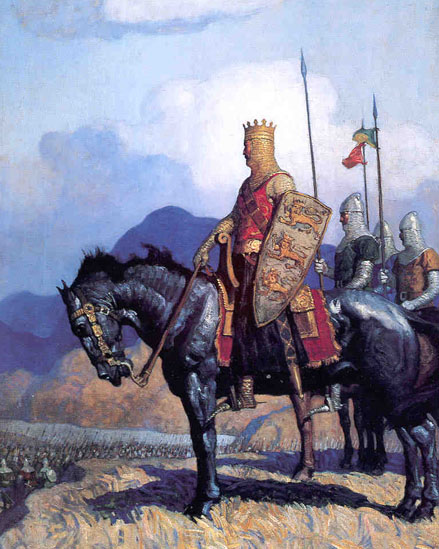
The revolts which broke out in early 1297, led by William Wallace, Andrew de Moray and other Scottish nobles, forced Edward to send more forces to deal with the Scots, and although they managed to force the nobles to capitulate at Irvine, Wallace and de Moray's continuing campaigns eventually led to the first key Scottish victory, at Stirling Bridge. This was followed by Scottish raids into northern England and the appointment of Wallace as Guardian of Scotland in March 1298. But in July, Edward invaded again, intending to crush Wallace and his followers, and defeated the Scots at Falkirk. Although Edward failed to subdue Scotland completely before returning to England.
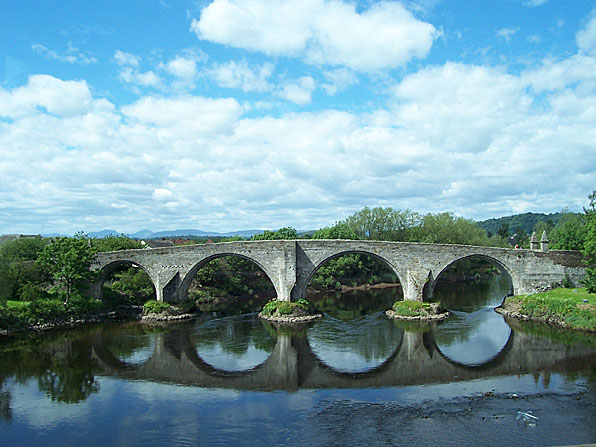
There have been, however, several stories regarding Wallace and what he did after the Battle of Falkirk. It is said, by some sources, that Wallace travelled to France and fought for the French King against the English during their own ongoing war while Bishop Lamberton of St Andrews, who gave much support to the Scottish cause, went and spoke to the Pope.
King Robert the Bruce: 1306-1314
Wallace was succeeded by Robert Bruce and John Comyn as joint guardians, with William de Lamberton, Bishop of St Andrews being appointed in 1299 as a third, neutral Guardian to try and maintain order between them. During that year, diplomatic pressure from France and Rome persuaded Edward to release the imprisoned King John into the custody of the Pope, and Wallace was sent to France to seek the aid of Philip IV, he possibly also travelled to Rome.

Further campaigns by Edward in 1300 and 1301 led to a truce between the Scots and the English in 1302. After another campaign in 1303/1304, Stirling Castle, the last major Scottish held stronghold, fell to the English, and in February 1304, negotiations led to most of the remaining nobles paying homage to Edward and to the Scots all but surrendering. At this point, Robert Bruce and William Lamberton may have made a secret bond of alliance, aiming to place Bruce on the Scottish throne and continue the struggle. However, Lamberton came from a family associated with the Balliol-Comyn faction and his ultimate allegiances are unknown.
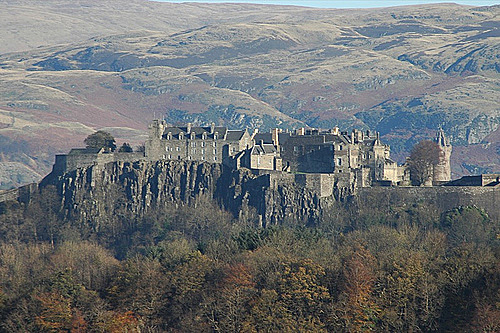
After the capture and execution of Wallace in 1305, Scotland seemed to have been finally conquered and the revolt calmed for a period. But in 1306, during a meeting between Bruce and Comyn, the two surviving claimants for the Scottish throne, Bruce quarrelled with and killed John Comyn. Comyn, it seems, had broken an agreement between the two, and informed King Edward of Bruce's plans to be king. The agreement was that one of the two claimants would renounce his claim on the throne of Scotland, but receive lands from the other and support his claim. Comyn appears to have thought to get both the lands and the throne by betraying Bruce to the English. A messenger carrying documents from Comyn to Edward was captured by Bruce and his party, plainly implicating Comyn. Bruce then rallied the Scottish prelates and nobles behind him and had himself crowned King of Scots at Scone. He then began a new campaign to free his kingdom. After being defeated in battle he was driven from the Scottish mainland as an outlaw. While hiding in a damp cave, considering giving up his seemingly forlorn cause, Bruce is reported to have watched a small spider trying to spin a line across a seemingly impossibly wide gap. As Bruce watched, the spider tried and tried and tried. "Foolish spider" thought Bruce, but continued to watch. Suddenly, the spider succeeded in leaping across the gap with its thread. Bruce considered this, and took it as an encouragement that he, too, should continue to persevere regardless of seeming circumstances. Bruce later came out of hiding in 1307. The Scots thronged to him, and he defeated the English in a number of battles. His forces continued to grow in strength, encouraged in part by the death of Edward I in July 1307. The Battle of Bannockburn in 1314 was an especially important Scottish victory.
From Bannockburn to Edinburgh-Northampton: 1314-1328
In 1320, the Declaration of Arbroath was sent by a group of Scottish nobles to the Pope affirming Scottish independence from England. Two similar declarations were also sent by the Clergy and Robert I. In 1327, Edward II of England was deposed and killed. The invasion of the North of England by Robert the Bruce forced Edward III of England to sign the Treaty of Edinburgh-Northampton on May 1 in 1328, which recognised the independence of Scotland with Bruce as King. To further seal the peace, Robert's son and heir David married the sister of Edward III.
King of England and France (His Claim)
Son-In-Law of Philip the Fair
Nemo me impune lacessit.
No one wounds me with impunity.






It then seemed that all was over, and Scotland utterly subdued. But surface appearances are often deceptive. A worthy successor to Wallace immediately took the field, and made heroic and supreme efforts to recover the kingdom.
Return to Persona Historiae
Return to Pagina Artis
Return to Bruce and Bobbie's Main Page.